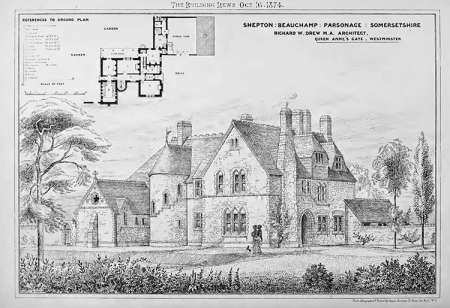Vicarage, (now Beauchamp Manor) Shepton Beauchamp, Somerset
SHIPTON BEAUCHAMP - A new parsonage has been built here. It has been designed with a view to providing facilities for holding choir meetings, adult classes, etc.; a passage, to which there is an external entrance, gives access to the prayer-room and study, and these, by an arrangement of double doors, can be thrown together. It is built of native stone walling, with Ham Hill stone dressings; the roof is covered with Bridgwater tiles. The work has been carried out by Mr. Davis, of Langport, from the designs of Mr. R. W. Drew, of Queen Anne's Gate, Westminster. [Building News 9 October 1874 page 446]
SHEPTON BEAUCHAMP PARSONAGE - We give ail illustration of this parsonage, to which we referred in our last week's issue. It has been planned to provide special accommodation for holding choir meetings, adult classes, etc. A passage shut off from the main corridor gives access to a prayer-room and study, and these, by means of an arrangement of folding doors, can be thrown together, and the whole length of the two rooms utilised; an external entrance to the passage gives admission to them without passing through the house. The prayer-room will be heated by a flue, on Captain Galton's principle, from the study fireplace. The house is built with native stone walls and dressings from the Ham Hill quarries, which are only a few miles distant. The use of this stone, on account of its rich colour and its capability of resisting weather, might with advantage be extended beyond the local limits to which it is chiefly confined. Bridgwater tiles have been used for covering the roofs, and blue lias stone for paving. The work has been executed by Mr. Davis, builder, of Langport. Mr. R. W. Drew, of 7, Queen Anne's-gate, Westminster, is the architect. [Building News 16 October 1874 page 458]
Designed as a clergy house for the rector, the vicar of Barrington, and visiting priests and students. It was described as 'rather plain and gaunt, with a central hall for meals, and an oratory without an altar but with a great crucifix and sacred pictures; where the "lesser hours" are said and confessions sometimes heard'. The house was sold in 1938 and was used for a time after 1948 as a religious guest house. It was known successively as St. Raphael, Holy Cross House, and the Old Rectory, and in 1975 was occupied as two dwellings called Beauchamp Manor.
